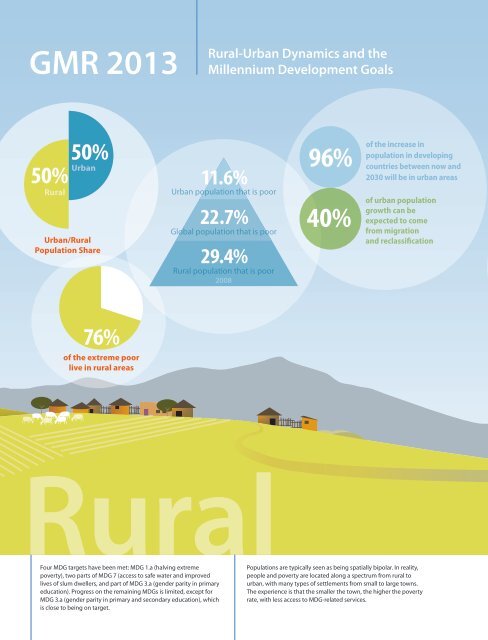rural-urban dynamics_report.pdf - Khazar University
rural-urban dynamics_report.pdf - Khazar University
rural-urban dynamics_report.pdf - Khazar University
Create successful ePaper yourself
Turn your PDF publications into a flip-book with our unique Google optimized e-Paper software.
GMR 2013<br />
Rural-Urban Dynamics and the<br />
Millennium Development Goals<br />
50%<br />
Urban<br />
50%<br />
Rural<br />
Urban/Rural<br />
Population Share<br />
11.6%<br />
Urban population that is poor<br />
22.7%<br />
Global population that is poor<br />
29.4%<br />
Rural population that is poor<br />
2008<br />
96%<br />
40%<br />
of the increase in<br />
population in developing<br />
countries between now and<br />
2030 will be in <strong>urban</strong> areas<br />
of <strong>urban</strong> population<br />
growth can be<br />
expected to come<br />
from migration<br />
and reclassification<br />
76%<br />
of the extreme poor<br />
live in <strong>rural</strong> areas<br />
Rural<br />
Four MDG targets have been met: MDG 1.a (halving extreme<br />
poverty), two parts of MDG 7 (access to safe water and improved<br />
lives of slum dwellers, and part of MDG 3.a (gender parity in primary<br />
education). Progress on the remaining MDGs is limited, except for<br />
MDG 3.a (gender parity in primary and secondary education), which<br />
is close to being on target.<br />
Populations are typically seen as being spatially bipolar. In reality,<br />
people and poverty are located along a spectrum from <strong>rural</strong> to<br />
<strong>urban</strong>, with many types of settlements from small to large towns.<br />
The experience is that the smaller the town, the higher the poverty<br />
rate, with less access to MDG-related services.

















